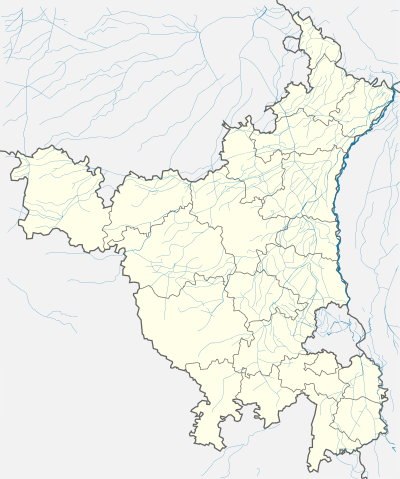Kalayat Ancient Bricks Temple Complex
| Kalayat Ancient Bricks Temple Complex | |
|---|---|
 Kalayat Ancient Bricks Temple Complex Location in Haryana  Kalayat Ancient Bricks Temple Complex Location in Haryana | |
| Name | |
| Other names | Kapil Muni, Tirth |
| Proper name | Kalayat Ancient Bricks Temple Complex |
| Devanagari | कपिल मुनि तीर्थ |
| Geography | |
| Coordinates | 29°40′16″N 76°16′01″E / 29.67111°N 76.26694°ECoordinates: 29°40′16″N 76°16′01″E / 29.67111°N 76.26694°E |
| Country | India |
| State | Haryana |
| Location | Kalayat |
| Culture | |
| Primary deity | Kapil Muni, Lord Shiva, Katyayini |
| Architecture | |
| Architectural styles | Indian architecture |
| Number of temples | 3 |
| Number of monuments | 2 |
| History and governance | |
| Date built | 8th century |
| Creator | Gurjar Pratihar |
The Kalayat Ancient Brick Temple Complex, also called Kapil Muni Tirth, the oldest surviving brick temple north of Delhi, is located in Kalayat town in Kaithal district of the state of Haryana, India. It comprises the several Hindu temples, including two ancient temples dating from the 8th century.[1] This temple constitutes an important point in the series of 48 kos parikrama of Kurukshetra.[2]
History
The temple, located in Kalayat, formerly known as Kapilayatana (home of the sage Kapil, is dated from archeological evidence as an ancient historical and religious place.[1] The brick temples were built and sculptured during the reign of Satavahana dynasty (230 BCE–220 CE). The temples represent the Panchayatana architectural style, similar to contemporaneous Khajuraho and Bhubaneshwar temples. They are the only surviving pre-Islamic temples of this kind in Haryana.[1] There is also an ancient Kapil Muni brick temple which is still in use. Kapil Muni was a proponent of dualistic Samkhya philosophy of Bhagavata Purana.[1] Later, this place came to be known as Kapilayatana (abode of Kapil). Legend has it that after Kapil Muni's death, a king of Satavahana dynasty (230 BCE–220 CE) came to hunt in the forest around Kapil Muni Ashram. He had a disease that rendered him paralytic at night. During the hunt his arrow struck the ground and as he pulled the arrow out, mud stuck on his finger which cured his fingers. Then he ordered a Tirth pond be dug so that people could be cured with the holy mud, and built the five brick temples.[3]
Temple complex

The temples were built in Nagara style of Gurjar Pratihara School. The layout of the temples indicates there were originally five temples in the Panchayatan group on the banks of holy Kapilayatna Tirtha (water tank). In the Panchayatan the main shrine was surrounded by four subsidiary shrines, which is contemporaneous to the temples of Khajuraho and Bhubaneshwar. Locally made red bricks were the main source of material for the buildings and sculptures. They were built without using any plaster or mortar. Only two temples survive. One temple is a Shiva temple in the Pancha Rathas style with a Linga statue and snake statue.[4] There are stairs at the back leading to the Kapil Muni Tirtha, where pilgrims take a bath before worship.[5]
The temple complex includes a large Kapil Muni Tirath. The Tirtha pond is named Chyavan Giri Kund after another Vedic sage Chyavana who regained health and youth by consuming Chyawanprash (made by RajVaidhya twin Ashwini Kumar brothers) at his Ashram on Dhosi Hill near Nuh in Mewat district.
There is also a temple of Katyayini devi who was the daughter of 3rd century BC Sanskrit grammarian, mathematician and Vedic Sage Kātyāyana[6] There is also a Hanuman temple and Akhara.
Access
Kalayat, where the temple complex is located, is connected by road. Rail and air links are available in the nearby major cities such as Chandigarh and Delhi.
Its distance from other major cities is as follows: kaithal 30 km, Jind 52 km, Kurukshetra 77 km, Hisar 90 km, Fatehabad 90 km, Panipat 95 km, Sirsa 133 km, Chandigarh 150 km, Ludhiana 159 km, Delhi 193 km, Dehradun 222 km, Shimla 250 km, Amritsar 287 km, Dharamsala 368 km, Agra 393 km and Khajuraho 820 km.
References
- 1 2 3 4 "Ancient Brick Temple". Government of Haryana Tourism Department. Retrieved 2014-11-22.
- ↑ http://kurukshetra.nic.in/bulkdata/pdf/tirthalist.pdf
- ↑ Kapil Muni Tirth
- ↑ Kalayat temples
- ↑ Kalayat in Haryana
- ↑ Kapilmuni Teerth (Kalayat): Haryana TV